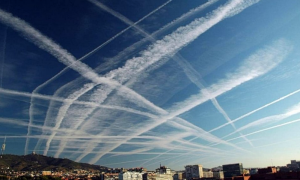Aug 15 2016
Peer-Reviewed Chemtrail Smackdown
 I love it when regular scientists decide to weigh in on a popular controversy. Recently scientists published a peer-reviewed paper in which they survey experts in atmospheric chemistry and atmospheric deposition over the nature of contrails and the claims that they are due to a secret large-scale atmospheric spraying program (SLAP), more commonly known as chemtrails.
I love it when regular scientists decide to weigh in on a popular controversy. Recently scientists published a peer-reviewed paper in which they survey experts in atmospheric chemistry and atmospheric deposition over the nature of contrails and the claims that they are due to a secret large-scale atmospheric spraying program (SLAP), more commonly known as chemtrails.
Chemtrails
This is definitely one of the more extreme conspiracy theories out there. In fact, the authors point to a 2015 survey in which only 2.6% of those surveyed said they believed in SLAP. That’s pretty rarefied conspiracy nonsense.
The idea is that those streaks of clouds behind jets are not just the result of jet engine exhaust causing condensation in the air (regular contrails), but that they are seeded with chemicals by the government for some secret and nefarious purpose. That purpose ranges from poisoning the population as a means of population control to controlling the weather.
Believers in chemtrails or SLAP use typical anomaly hunting to support their belief system. They cite the fact that some contrails persist in the atmosphere longer than others as a major piece of evidence. Those with the secret chemicals last longer. They also look for other anomalies, such as broken contrails or contrails that look colored instead of white, or that have an apparent spiral pattern to them.
There is no a-priori reason to conclude that any of these alleged anomalies are evidence of chemicals in jet exhaust. This is classic anomaly hunting – look for anything strange, then weave some handwaving explanation for why this apparently strange feature is due to the phenomenon you want to prove. Humans are good at making up explanations for things, which is a lot easier than critical analysis or understanding the science.
The most remarkable thing about this paper, in my opinion, is that they open by explicitly making the case for why scientists should be addressing such issues. They make a good case, citing evidence that doing so actually affects public opinion. Further, seemingly benign conspiracy beliefs like this one are “gateway” beliefs to other, perhaps more pernicious, conspiracies. Finally, fake controversies take attention away from more pressing issues, like pollution and climate change, for example.
It is also interesting that the authors feel they need to make the case for addressing such issues. They are understandably defensive, which reflects the culture in science and academia that addressing conspiracies and pseudoscience is somehow dirty.
That is exactly wrong.
Science should not be an ivory-tower academic pursuit. It very much should be embedded deeply into society. It exists not only to advance human knowledge, but to guide human policy and to help society. It cannot expect widespread support otherwise.
It does not help society if scientists are figuring out how things work, but they are ignored by politicians while the general public debates pseudoscientific fake controversies. Scientists need to jump in, to address silly claims and to make their scientific knowledge relevant. Silly beliefs are teaching opportunities. They are a great way to increase scientific literacy and enthusiasm.
The Details
The details of the survey are also interesting, but they are just the icing on the cake. The take home for most people is that out of those 77 atmospheric scientists who responded to the survey, only 1 said they had ever encountered evidence to suggest a SLAP existed. Specifically:
The one participant who answered yes said the evidence s/he had come across was ‘high levels of atm[ospheric] barium in a remote area with standard ‘low’ soil barium’.
Further, the scientists were shown photos of the four alleged lines of evidence for chemtrails – persistence, gaps, colors, and spirals. Zero percent said they felt any of these were evidence for SLAP or that a SLAP was the best explanation for them. They offered several other much simpler and more plausible explanations.
For example, difference in atmospheric temperature and humidity can explain how long contrails persist, and can also explain gaps in contrails. Light refracting through ice crystals can cause apparent color. Flight patterns and wind patterns can cause spiraling of the contrails.
The overall response rate to the survey is 29.5%, which is not bad for such a survey, but that is the weakness of this kind of study – it is self-selective and therefore not necessarily representative. Believers in contrails are free to find atmospheric experts who disagree with the survey results.
Believers will also argue that this is an argument from authority, which misses the point. The purpose of the survey is to find out what experts believe about chemtrail theories, if they have ever encountered anomalies, and if they have explanations for the alleged anomalies to which believers point as evidence.
The fact is, experts do have detailed explanations for the alleged atmospheric anomalies that believers point to, so the onus is now on believers to explain why SLAP is a better explanation for the observed phenomena than those offered by the experts.
The authors also point out that the purpose of this paper is not to convince true-believers, “who often reject counter-evidence as further proof of their theories.” Rather, this is to provide a resource for the general public, who may hear about such theories and not know what to think, or who are on the fence. The ready availability of such information could prevent some people from falling down a rabbit hole of conspiracy thinking.
Good for them. We need more scientists willing to publish such work.






